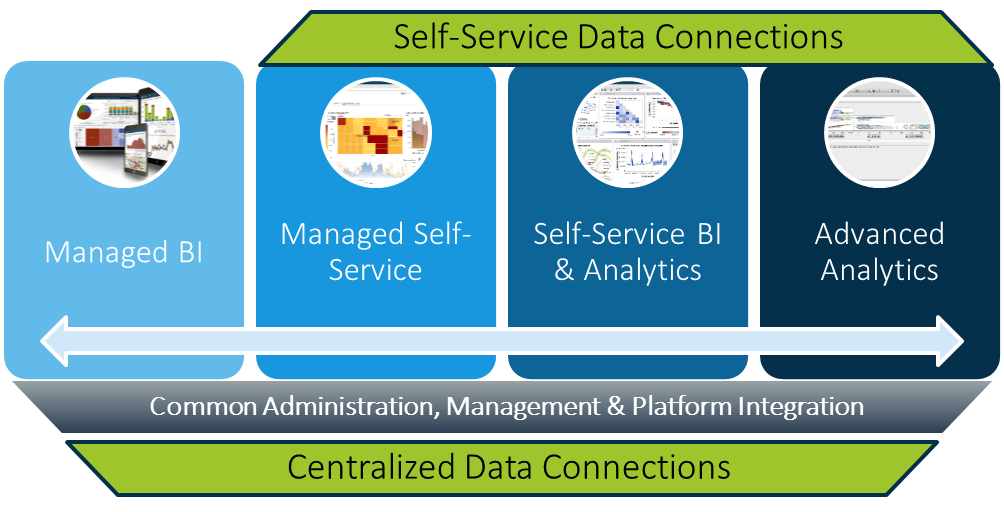Hitting the right balance between the agility of self-service business intelligence (BI) and the trustworthiness of governance is difficult. What I often see is that users tend to ignore governance blinded by the aesthetics of self-service visualization tools. As we all know, all that glitters isn’t gold, so how do you make sure that even self-service “hipsters” can serve them inventive new dishes while preventing waste in your organization? I want to share with you my thoughts on self-service BI in this post, along the analogy of eating – or serving – salmon with ice cream. A unique food combination I observed while filling my plate at a self-service buffet.
Self-service buffets may get you into trouble – Parenting might be the answer
On the ferry from Norway to Denmark one summer, I saw a girl having salmon and ice cream on the same plate from the self-serviced buffet. It surely was an out of the box thinking and innovative approach, I thought. She threw away most of the meal after a few mouthfuls. It appeared to me that if someone would have advised her not to have salmon with ice cream on the same plate – because it does not go well with one another – she might have opted for a different serving at the buffet. The possibilities of self-service, and the choices that came with it, might have overwhelmed her a little. A few years later though, I googled salmon and ice cream.
The ease of use and neat visualizations of self-service tools are a hit, and they make data come alive with their stories. Eye candy, basically. “A picture is worth a thousand words,” as they say. The agile nature of the tools makes a big difference for self-serviced users and their use of data in decision making processes. You may download a client, and off you go. IT WORKS GREAT! But is this really all you have to think of using your organization’s data?
We take decisions every single day. They can be easy, and they can be life changing. Some are based on evidence and many are based on intuition. The good ones we try to repeat, the bad ones, at best, we learn from or try to forget. We humans are also experts at decision automation. We even try to build machines that can outperform our cognitive abilities.
Business intelligence connects to your business operations, and the stream of data from these operations you need to communicate. In my work with customers, I try to map exactly this: what do they need to do in order to turn their decisions into actions with Business Intelligence and the spices of being self-serviced? How can it all stay trustworthy?
Four buckets approach – The self-serviced organization
From my experience during many projects, I began to categorize what kind of support the customers were in need of and divided them into four buckets – including how they could be governed.
Figure 1 Self-Service comes in many forms
Managed BI – “spread the word”
This is the most controlled approach. Here, data gets turned into information by someone who knows the requirements before the content gets distributed. The end user may subscribe to content that is relevant, and have a front-end that allows them to search, drill-down, identify and target the information of interest with ease. This is BI for the masses and terms like ‘report’ and ‘app’ are often used to describe these tools.
Managed Self-Service – “power to the business user”
This is the part of the process where you allow users to make their own “apps”, do data discovery, create their own reports, add their data sources in the form of their own spreadsheets, often in combination with centrally handled data sources and so forth. You create your summarized statistics with ease and flexibility of on-the-fly hierarchies and calculations. Using data is far easier than having to use pre-aggregated structures and older technology like OLAP. This is where the users want to be today and how they want to use data. You introduce both new possibilities as well as the potential of faulty use of data if you give ‘power to the business user’. Like the girl standing in front of the self-service buffet on the ferry, bad choices might be made here, unless your organization has a good, structured way of making the self-service buffet a success.
Managed Self-Service BI & Analytics – “smarter power to the business user”
This is the part where you truly add analytics to the process and delve into the diagnostics of any given situation. Why did it happen? What are the drivers that could explain this?
With ease, you start using your data smarter because you start including analytics. I call this ‘democracy of analytics’: You provide users with more advanced statistical functionality using point and click techniques. Decision trees, correlation, forecasting, scenario, text analysis and path analysis are extremely helpful in the context of your diagnostics work. This kind of functionality allows you to identify patterns far easier than before.
Advanced Analytics – “Ignite your rocket engine 10…9…8...”
What will happen and what is my best option? This is where you can really make an impact using data analytics in your organization. This is the level where you actually optimize your decisions using data. The ones working with these parts are the ones that truly know – and understand – the mathematics behind it all. They sort out the validity of the evidence that exists in your data.
It’s all about parenting
I see self-service BI as serving yourself with the data and presentation of it, where, when and how you might need it. The “how” part correlates with the degree of self-service and you need to handle this carefully. The “needs” span from simple to complex depending on the situation. The more a need is repeatable and the broader the interest in it, the more you can standardize and try to centralize into a managed BI approach.
If the girls’ parents had guided her in the decision of what to eat, they might have prevented her from choosing a dish she was likely not to finish. The self-service buffet made the girl self-serviced and her parents saved time they would have otherwise spent on choosing a meal for her. They probably also saved the effort of asking her questions like “what do you want to eat?”, and “how hungry are you?” As a parent myself, I know how time consuming this questioning game can be. The efficiency of the eating process was more agile and less time consuming than it might have been using another approach.
Still the result was waste! The girl was not in control of her need and the ice-cream machine to tempting. The balance between self-service and governance is much like parenting. IT and business need to find a way of collaborating in a process of balanced self-service BI. Great technology enables this, but the rest – the actual work – has to be carried out by your people, supported by your processes.
My colleagues and I have would be most happy to support you with techniques, methods and skills that have already been implemented successfully and will ensure you will be able to balance the possibilities.
If you’re up for a chat about the possibilities of applying self-service or our technology to your organization and processes, please don’t hesitate to get in touch! You can contact me on LinkedIn.
For further reading about “data strategy”, I suggest the free whitepaper “The 5 essential components of a data strategy”.
Join the discussion on Twitter
I also encourage you to join our #saschat on Friday 27th January 15:00 CET. Here are the questions we cover:
Q1: What factors have most influenced trends in analytics self-service over the past 12 months?
Q2: How is the challenge of providing departments with more agility in data management best handled?
Q3: How have self-service approaches kept pace with data governance and regulatory requirements?
Q4: What determines the role of data quality in data preparation?
Q5: How do self-service techniques fit with existing data warehousing and business intelligence processes?


